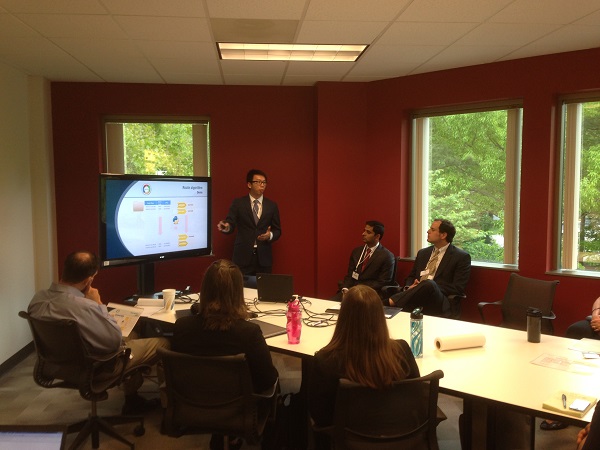
Front (L-R): Krista Loaiza and Ashok Janakiraman. Back (L-R):
Natali Ojeda Meneses, Patrick Williams and Henry Huang.
Knowing with accuracy the arrival time of a railcar can help to ensure the efficiency of a supply chain. It can cost money and cause logistics headaches if a truck arrives at a railroad’s intermodal facility long before or long after the train carrying the intermodal container gets there.

Railinc’s role is to support freight railroads and their customers by providing data that helps logistics planners avoid such costly scenarios. Recently we found that outside assistance from budding data experts can offer a fresh perspective on old problems.
From October to April, a team of five graduate students from North Carolina State University's Institute for Advanced Analytics worked with Railinc to develop a predicted estimated time of arrival (PETA) model that would enhance the reliability of PETAs Railinc provides its customers. They presented their results at Railinc on April 29 (right).
The project was part of the institute's practicum program.
"In my experience, working on a practicum project was one of the best parts of the program," said Lauren Passarella, a Railinc data scientist who graduated from the analytics program in 2011. "It really helps to you prepare for the challenges of working in the real world, including gaining experience working with real data, which is never as perfect as the examples in class."
Drawing Out Insights from Big Data
Railinc provided three months of historical event and waybill data tables with more than 500 million records, as well as a standard point location code reference table. (Project teams are required to maintain the confidentiality of the data and their results.) The students met with Railinc employees in Cary and at N.C. State over the course of the project to discuss their progress and the data.
"I enjoyed learning about the details of the rail industry that I never knew about," said team member Krista Loaiza. "This was my first real project where I got to learn about how to deal with big data and use my knowledge to help solve a real-world problem."
The students developed a prototype predictive model to generate PETAs. They used the accelerated time failure (AFT) model to predict railcar travel times from origin to destination. They also developed a tool for calculating possible railcar routes. While there was some variance in outcomes (their average case was 3 hours and 26 minutes earlier than the actual arrival time), their hard work yielded valuable insights for Railinc data scientists.
"We gave the students a huge amount of data from an industry that was new to them," said Andy Adams, a Railinc product manager who worked with the NC State team. "We were impressed by what they came back with and the potential their work could have in helping us calculate more accurate PETAs and in creating positive results for the freight rail industry."
Practicum Helps N.C. State Students Hone Their Analytics Skills
In addition to Loaiza, the N.C. State student team included Henry Huang, Ashok Janakiraman, Natali Ojeda Meneses and Patrick Williams. This was their final school project before moving on to data analytics positions in banking, pharmaceuticals and other industries.
The practicum is the cornerstone of the Master of Science in Analytics experience and allows students to hone their skills on the kinds of analytics problems organizations grapple with every day, said Dr. Michael Rappa, director of the Institute for Advanced Analytics.
"We're grateful to sponsors like Railinc, who generously set aside their time to define exciting and challenging projects, share data and then engage with the student team over the project's eight-month duration," Rappa said. "Railinc is at the nexus of an industry where the careful application of data analytics can play a crucial role in the future."
—Railinc Corporate Communications
